Stars of the Sea
Stars of the Sea
Ahoy! It’s officially Academy Award season and a lot of eyes are focused on the stars of Hollywood, but do you know there’s a red-carpet affair going on everyday beneath the brilliant waters of the Caribbean? The best part? You don’t need a formal invitation to show up and you don’t have to buy a designer gown or rent fancy jewels. Simply don a mask and pair of fins and propel yourself to the nearest reef. While no one is handing out Oscars for your efforts, you might just catch sight of some amazing, colorful action that rivals the imaginative dramas captured on film. Here are my nominations for the best “actors” and “actresses” that frequently put on a show throughout the bays and coves of the Virgin Islands.
Most Congenial – Some of these flashy, friendly tropical swimmers are known to greet you face to face!
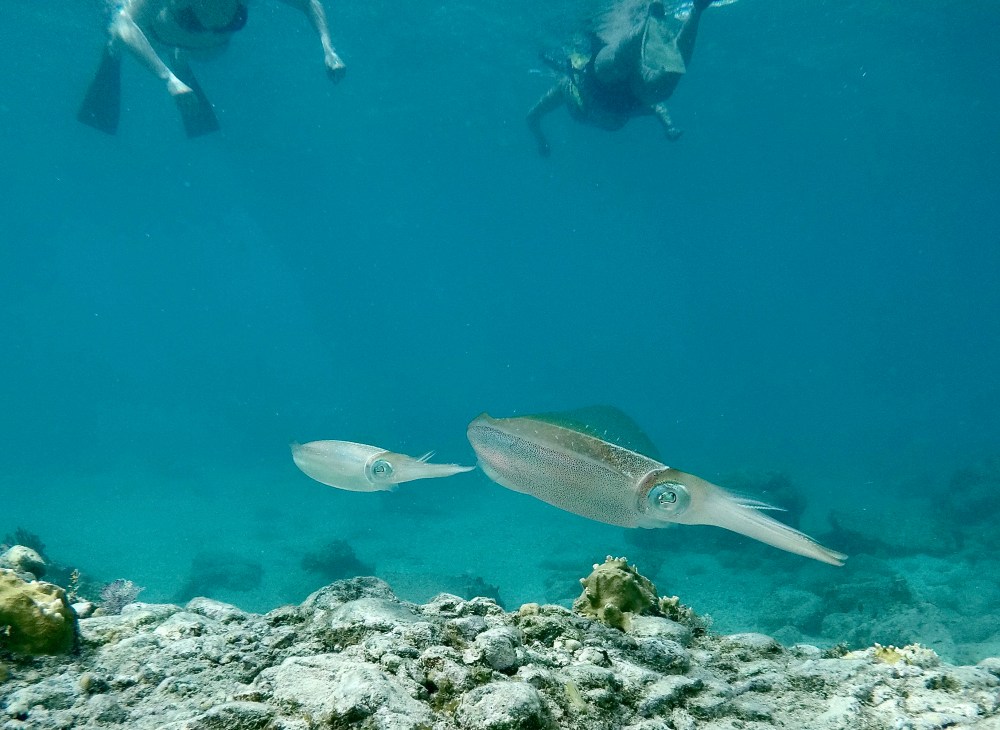
Some of our guests swimming with Reef Squid
- Reef Squid – These highly intelligent and often entertaining beauties seem almost curious about humans. Forget the giant squids shown in sci-fi movies. Reef squid are small, torpedo-shaped fish that have undulating fins which gracefully flutter like the arms and fingers of a ballerina. These squid can change color almost instantly, sometimes glowing with iridescent reds, yellows and greens, or they can become more mysterious with shades of dark brown or gray. Despite their small size, they consume 30% to 60% of their body weight daily by eating other small fish, molluscs and crustaceans. Like other cephalopods, reef squid die after reproducing.
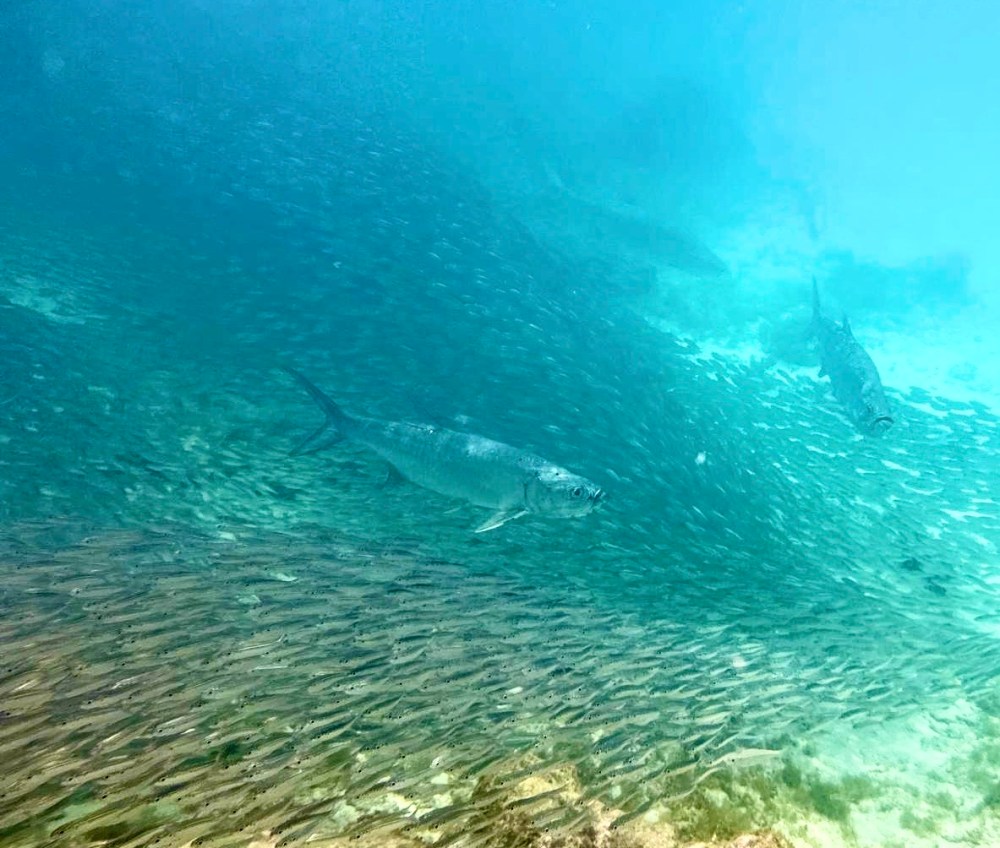
Tarpon Swimming through bait fish
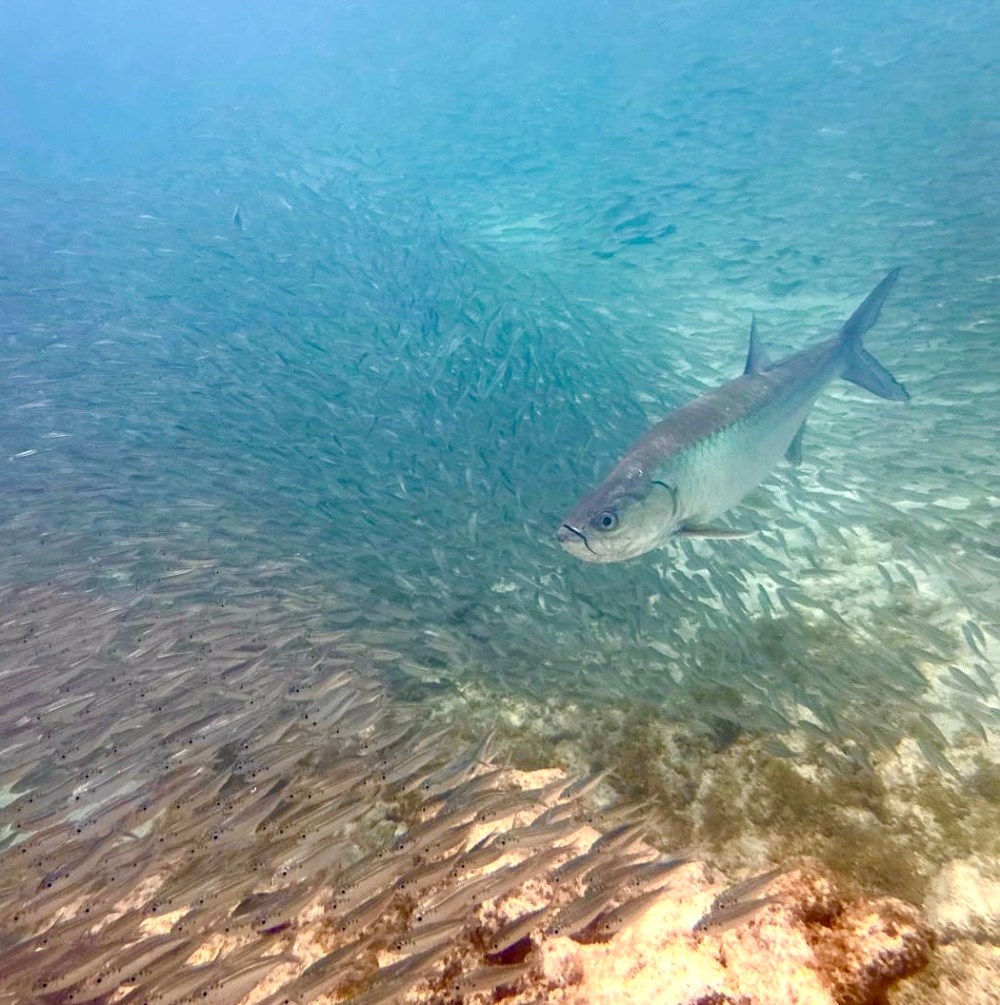
A Tarpon swimming through a school of bait fish
Tarpon – Tarpon are some of the largest fish that you might encounter while snorkeling in the Virgin Islands. These gentle giants with shiny, silvery scales are often well over four feet in length, sometimes nearing a whopping eight feet. With large eyes, a broad mouth and a prominent lower jaw, tarpons may appear menacing, but they seldom seem spooked by humans swimming nearby. Most often you’ll find them in small groups or pairs as they slowly cruise through the water, often surrounded by schools of silversides. Perhaps it’s happenstance, but every time I’ve ever encountered a few tarpon, I’ve also spotted a shark nearby – so keep your eyes peeled for a nurse or lemon shark lurking in the shadows. One amazing fact: tarpon can lay up to 12 million eggs at once, which certainly gets an “A” for effort!
Best Costume – These flamboyant swimmers are rainbows in motion.
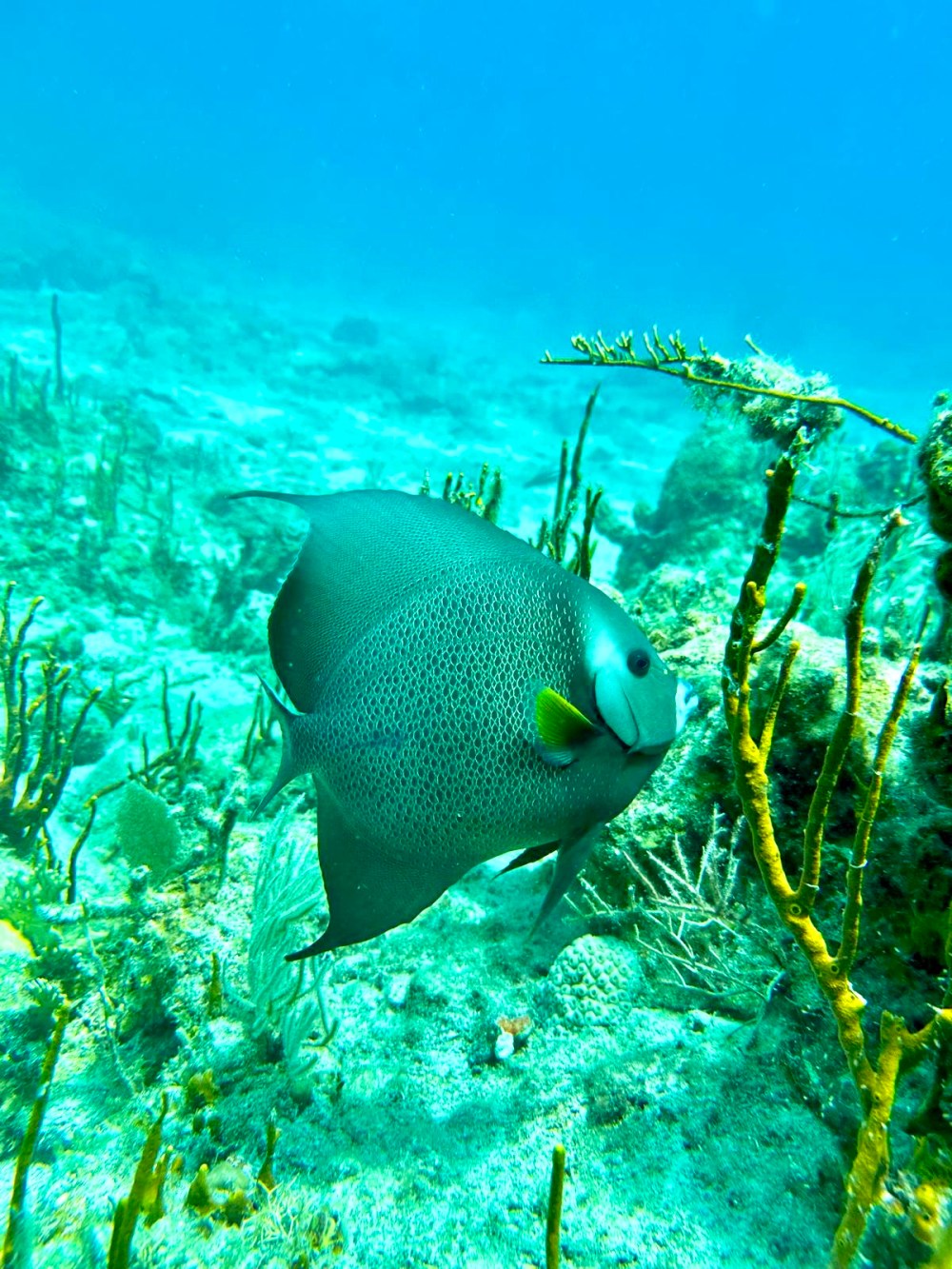
Angle Fish
Angelfish – Known for their curiosity, this species with its discus-shaped bodies and triangular tail fins is loaded with flamboyant colors. Rock Beauties boast lemon-yellow hues with a dark spot that increases in size until the fish is full-grown at about one foot. Juvenile blue angelfish are drenched in midnight blue with yellow fins and tail, while adult fish appear more green with accents of blue and an impressive yellow border along the tail. An adult queen angelfish, easily identified by an eye-like spot known as a “crown” that is cobalt blue with an electric blue outer ring on the forehead, is stunning in its robe of blue, highlighted by yellow-rimmed scales and a yellow tail. Inhabiting healthy coral reefs, this species primarily eats sponges and breeds near the full moon. Transparent eggs float in the water until they hatch.
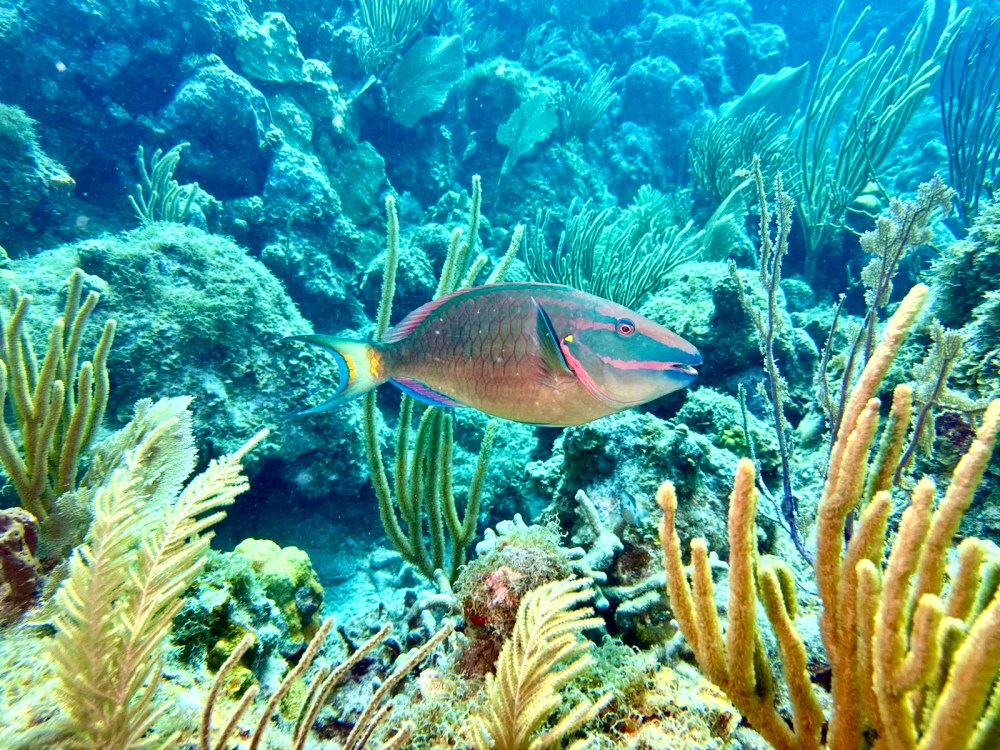
Parrot Fish
Parrotfish – Females and males are both colorful, but males are the gaudiest. Parrot fish range in colors from bright red to midnight blue to brown. Rainbow parrotfish look like fine mosaics with purple, turquoise, green and pink scales. This species is easily identified by its teeth which are fused together in parrot-like beaks. Known for their ability to grind coral and rock into fine sand, these fish are responsible for the white sand that lines the shores of the Virgin Islands. (Yes, that beautiful sand is actually parrotfish poop!) Being daytime feeders, the fish often congregate together as they munch away on coral, while at night, they sleep under ledges and in caves cocooned in a protective mucous membrane until morning.
Best Group Choreography – Rarely found alone, these fish swim in large groups and appear to dance and turn in harmony as though listening to strands of music only they can hear.

- Horse-eye Jacks – These elongated silver-bodied swimmers with gold tails and dark, penetrating eyes traverse the shorelines of most bays. It’s not unusual to see 30 to 50 horse-eye jacks swim en masse, furiously heading in one direction, only to suddenly reverse course as though playing follow the leader.
- Blue Tang – Nothing is more beautiful than sighting a group of Blue Tang. They, too, swim in very large groups, appearing as a blue cloud of dust that sweeps by in graceful flutters. These round-shaped fish, which belong to the surgeonfish family, can range in size from a few inches to as large as 15 inches, though size is not related to age. Juveniles are actually bright yellow with neon blue highlights on the upper part of their bodies. Older fish range in color from light to dark blue, as well as darker shades that appear more purple or black. All adults have poisonous spines on both sides of their bodies just in front of their tail fins.
Best Of Show – Although these two nominees are vastly different in size, they both can put on a show that will dazzle and inspire you.
- Humpback Whales – These enormous, fascinating creatures that can reach a length of 52 feet are quite the showstoppers. Although humpback whales normally reside in the North Atlantic, they migrate to the Virgin Islands during the winter months to give birth, then return home when spring arrives. Stormy Pirates guests typically will see of mothers and their calves breaching in the waters between St. John and St. Thomas. It’s definitely a camera-worthy moment that will make your jaw drop and your heart sing.

Humpback Whale breaching Taken by Captain Tyler

Humpback Whales next to our boat Buccaneer

Mother and Calf Humpbacks under the water.
- Common Octopus – I still remember my first sighting of a Caribbean reef octopus which happened in Salt Pond Bay. It was white and swimming beneath me, but the moment it noticed my presence, it dropped onto a rock and changed into various shades of brown, even changing the texture of its skin to make itself indistinguishable from the rock. The depth of the water was only about two feet. I’ve since learned to look closely at the rocks forming any reef so that I might spot the eyes of the octopus which open and close to check out its surroundings. These intelligent creatures feast on crabs, shrimp, lobster, clams and small fish. (Finding a pile of discarded clam shells can be a sign that an octopus is nearby.) These solitary critters are nocturnal and are a tempting delicacy for sharks and stingrays.
Most Elusive – This category gets three nominees, and count yourself extra lucky if you get the opportunity to catch sight of any one of these intriguing, hidden stars of the sea.

Flounder
- Peacock Flounder – Unless you catch one of these flat, oval shaped fish swimming horizontally through the water, you won’t even notice a peacock flounder’s presence because they, like the octopus, can adeptly blend into their perching places. Most peacock flounders are six to eight inches in length with tan-to-white bodies covered with beautiful blue spots and blue fringes around its entire body. Both eyes appear on the upper side of its body.
- Manta Ray – Also known as “devil fish” due to the two horn-shaped fins protruding from the front of its head, this massive member of the ray family has a dark, flat, diamond-shaped body with triangular pectoral fins. Giant manta rays have the biggest brains of any fish and are responsible for controlling plankton abundance and diversity. I’ve only ever seen one, and I saw its shadow in the waters off of Francis Bay on St. John before I grabbed my mask and dove into the water to check it out. The manta ray was the size of a small car, and it seemed to take delight in chasing frightened people out of the water. “Prehistoric” was the word that came to mind as it seemed other-worldly in its size and behavior. Truly unique and spectacular!
- Seahorse – These dwarf spiny creatures are found in shallow, sheltered areas like seagrass beds, coral reefs or mangroves. With a head and neck suggestive of a horse, along with bony armor, an upright posture and a curled prehensile tail, these fascinating fish also appear other-worldly. Definitely grab your camera if you go hunting for seahorses so you can boast away with proof if you find one. The pictures below are from our Crew Member Kevin’s encounters with them at a secret spot off of St. Thomas.


Best Supporting Cast Members – While not as mobile as their fellow sea creatures, these “stars of the sea” are no less noteworthy.
- Conch – These medium-to-large-sized sea snails live in a large shell that comes to a point on both ends. Prized as a culinary offering on many Caribbean menus, conch is also used as fish bait. Spend the day at Maho Bay on St. John and you’ll probably see at least a half dozen or more of the large shells resting in the sand beneath the beds of seagrass. Do not remove the shells from the water as conches are quickly becoming an endangered species and efforts are underway to protect them.
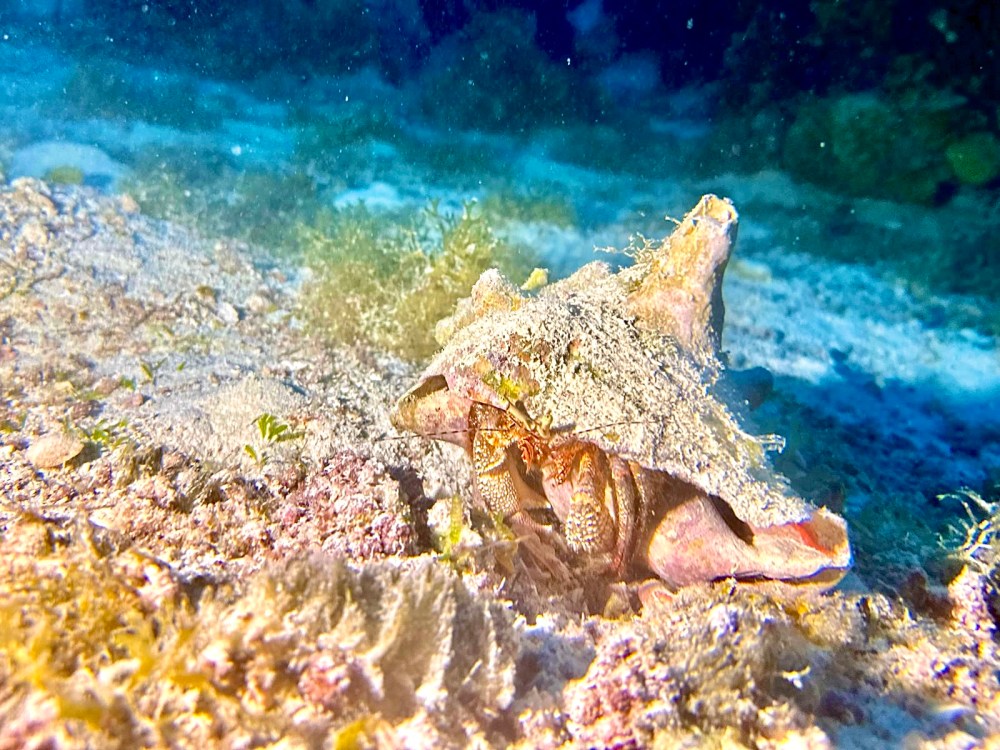
Conch Shell with a crab living inside
- Starfish – There are some 1900 species of starfish in all of the world’s oceans, including those that live in frigid waters and those that thrive in tropical settings. The starfish common to the Virgin islands vary in color from red to orange to tan. Known as Cushion Sea Stars, these exquisite creatures have a boney, raised surface and while most have five arms, it’s not uncommon to find others with only four arms or the occasional one that has six! While I’ve spied them in many of the numerous snorkeling spots, you undoubtedly will find them on the bottom of Leinster Bay. Please, please don’t touch them or remove them from the water. They are like works of art, meant for viewing but not touching!


- Sea Turtles – There are three species of turtles in the Virgin Islands, all of which are protected. The green and hawksbill turtles are the most common, while the leatherback is a rarity. Do you know that Trunk Bay is actually named after the leatherback which used to appear frequently in that area? Legend has it that when the Danes settled in the Virgin Islands, they called the leatherbacks “Trunk” turtles because they looked like steamer trunks as they floated in the water. Green turtles are the most common and can weigh in at 500 pounds. Hawksbill turtles are smaller and can reach a weight of 150 pounds. While turtles can be found just about anywhere in the Virgin Islands, I’ve never visited Maho Bay and not seen at least two or three of these slow-moving characters who spend their days happily munching on seagrass.


Safety Tips For Snorkeling
- Know your own swimming abilities and endurance limits. Don’t snorkel in places with strong currents or dangerous rip tides.
- Never touch the fish, rocks or seagrass with your hands or your fins. If you need to stand up, place your feet in a patch of bare sand, otherwise you can contaminate or injure the ecosystem.
- Use a buddy system so if you need help, someone is there to assist you.
- Protect your skin with reef-safe sunscreen. It’s easy to get a bad sunburn on your back while snorkeling.
- Never snorkel after consuming a lot of alcohol.
- Learn to scan the water for fish, rather than simply looking straight down into the water. You’ll see a lot more wildlife by slowly rotating your view in all directions.
- Move s-l-o-w-l-y. Snorkeling is not a race or a contest. It requires patience.
- If it’s your first time to snorkel, work with a charter company like Stormy Pirates who will supply your gear, show you the ropes and keep an eye on you, too.
End Notes: Want to know more about the best snorkeling locales or how you can catch some of these award-winning stars in action? Then visit our website and book a boat day with Stormy Pirates Charters – we’ll put the gang plank down and escort you in style!
Special thanks to our mate Kevin Flanagan for most of the underwater photos in this blog.
